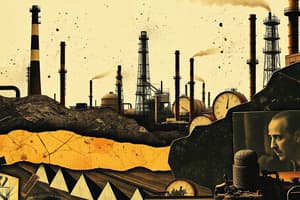Podcast
Questions and Answers
What is the main purpose of fuel atomization in the combustion process?
What is the main purpose of fuel atomization in the combustion process?
- To reduce the pressure inside the nozzle
- To decrease air supply to the combustion chamber
- To increase fuel viscosity
- To ensure efficient combustion by breaking fuel into tiny particles (correct)
Which type of atomizer uses ultrasonic vibrations to break the fuel stream into droplets?
Which type of atomizer uses ultrasonic vibrations to break the fuel stream into droplets?
- Electrostatic atomizers
- Pressure atomizers
- Rotary atomizers
- Ultrasonic atomizers (correct)
What factor related to nozzle design influences the size and distribution of fuel droplets?
What factor related to nozzle design influences the size and distribution of fuel droplets?
- The shape, size, and arrangement of nozzles (correct)
- Fuel properties
- Viscosity, surface tension, and density of fuels
- Ultrasonic vibrations
In which step of the fuel atomization process does the liquid fuel break into droplets?
In which step of the fuel atomization process does the liquid fuel break into droplets?
What factors influence the liquid breakup process in fuel atomization?
What factors influence the liquid breakup process in fuel atomization?
Why is it challenging to atomize high-viscosity fuels?
Why is it challenging to atomize high-viscosity fuels?
What is the role of air entrainment in the fuel atomization process?
What is the role of air entrainment in the fuel atomization process?
Why is atomizer fouling a challenge in the atomization process?
Why is atomizer fouling a challenge in the atomization process?
In what applications does atomization play a significant role?
In what applications does atomization play a significant role?
How does atomization contribute to the combustion process in internal combustion engines?
How does atomization contribute to the combustion process in internal combustion engines?
Flashcards are hidden until you start studying
Study Notes
Fuel Atomization: Breaking Down Fuel for Efficient Combustion
Atomization is the process of breaking fuel into tiny particles, ensuring that it mixes well with air in the correct proportion to achieve efficient combustion. This technique plays a vital role in a wide range of applications, from internal combustion engines to industrial boilers.
Atomizer Design
Atomizers are the devices that produce fuel droplets. There are several types of atomizers, including:
-
Rotary atomizers: These devices use a rotating element, such as a disc or rotator, to shear the fuel stream and generate tiny droplets.
-
Pressure atomizers: Fuel is forced through a nozzle, where it experiences high pressure and shear forces, breaking up into droplets.
-
Ultrasonic atomizers: Ultrasonic vibrations break the fuel stream into droplets.
-
Electrostatic atomizers: These atomizers use electrostatic forces to break up the fuel stream into droplets.
Atomizer design factors that influence the quality of fuel droplets include:
- Nozzle design: The shape, size, and arrangement of nozzles determine the size and distribution of droplets.
- Fuel properties: The viscosity, surface tension, and density of fuels affect the droplet size and stability.
Fuel Atomization Process
The fuel atomization process can be broken down into three main steps:
-
Liquid breakup: The fuel breaks into droplets as it exits the nozzle or passes through the atomizer. The liquid breakup process is influenced by factors such as nozzle design, fuel properties, and pressure.
-
Droplet evaporation: As the droplets enter the combustion chamber, they evaporate, forming a spray of fuel vapor and liquid droplets. The size and distribution of droplets play a crucial role in the combustion efficiency and emissions.
-
Air entrainment: The droplets are surrounded by air, which further evaporates the fuel and promotes efficient mixing. The air entrainment process affects the fuel's combustion rate and emissions.
Atomization Challenges
Atomization can be challenging due to factors such as:
-
Fuel properties: High-viscosity fuels and those with high surface tension can be difficult to atomize, leading to poor mixing and reduced combustion efficiency.
-
Atomizer fouling: The formation of deposits on the surface of nozzles can affect the atomization process and lead to reduced performance. Fouling can be caused by a variety of contaminants, including solid particles, water, and corrosion products.
Atomization Applications
Atomization plays a significant role in various applications, including:
-
Internal combustion engines: In engines, atomization ensures that fuel mixes well with air, promoting efficient combustion and reduced emissions.
-
Industrial boilers: In boilers, atomization is essential for mixing fuel with air, ensuring that the combustion process is both efficient and clean.
-
Spray coating: Atomization is used in spray coating applications to create uniform coatings on various surfaces, including automotive parts and industrial equipment.
Atomization is a critical process in the efficient and clean combustion of fuels. While the challenges associated with this process are not insignificant, innovative solutions and advances in technology continually push the boundaries of fuel atomization, ensuring that the combustion process remains both efficient and environmentally friendly.
Studying That Suits You
Use AI to generate personalized quizzes and flashcards to suit your learning preferences.



